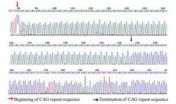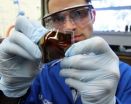(Press-News.org) VANCOUVER, BRITISH COLUMBIA – A new study of Utah youth with suspected sports-related head injuries found that emergency room visits for children with sports-related head injuries have increased since the state's concussion law passed in 2011, along with a rise in head CT scans -- leading to potentially unnecessary radiation exposure.
The results were announced at the Pediatric Academic Societies conference in Vancouver, British Columbia in May by William McDonnell, M.D., J.D., associate professor of pediatrics at the University of Utah.
The study, completed by McDonnell and other University of Utah faculty, examined Intermountain Healthcare's emergency department database for 19 hospitals in Utah between September 1, 2009 and September 1, 2012. Researchers wanted to know if the number of children and teenagers with suspected sports-related head injuries between ages 6 and 18 who came to hospital emergency departments changed, if the number of CT scans grew, and what those scans revealed.
Like 48 other states, Utah passed a concussion and youth sports law intended to protect children. Utah's law states that a youth suspected to have a concussion or traumatic head injury must be removed from play, evaluated by a qualified medical professional, and cleared before he or she can return to play.
"It sounds so reasonable to everyone," McDonnell said. "And we all want to treat children's injuries, and prevent them whenever possible. For that reason [these kind of laws] have flown through state legislatures."
Comparing ER visits before and after the law, the researchers found that the number of children coming in for a suspected sports-related head injury went up 43 percent in one year after the law was passed. The total number of CT scans on these children increased 17 percent.
Of the scans completed on 61 additional children in the year after the law was passed, 54 were negative -- meaning the child's head was not seriously injured. On the other hand, a few more serious head injuries were caught.. The study is ongoing.
"What I don't want this study to come across as is saying concussions don't matter," McDonnell said. "They definitely do -- but the important thing is to treat them medically correctly."
The researchers are not ready to say whether Utah should change its law. However, they believe that legislators and state health policy makers need to consider the effects of the law.
"We think people need to recognize there are costs and benefits," he said.
INFORMATION: END
Study reveals potentially unnecessary radiation after suspected sports-related injury
2014-05-05
ELSE PRESS RELEASES FROM THIS DATE:
New research explores how smoking while pregnant leads to other diseases
2014-05-05
VANCOUVER, BRITISH COLUMBIA – While many parents-to-be are aware that the health of their baby starts before they've actually arrived into the world, recent research reveals that "harm" (i.e., tobacco smoke, dirty air, poor nutrition, even preeclampsia) may not present itself disease-wise until well into adulthood or when a second harmful "hit" triggers the individual's susceptibility.
The results were announced at the Pediatric Academic Societies conference in Vancouver, British Columbia in May by Lisa Joss-Moore, Ph.D., University of Utah Department of Pediatrics. ...
Uncorking East Antarctica yields unstoppable sea-level rise
2014-05-05
The melting of a rather small ice volume on East Antarctica's shore could trigger a persistent ice discharge into the ocean, resulting in unstoppable sea-level rise for thousands of years to come. This is shown in a study now published in Nature Climate Change by scientists from the Potsdam Institute for Climate Impact Research (PIK). The findings are based on computer simulations of the Antarctic ice flow using improved data of the ground profile underneath the ice sheet.
"East Antarctica's Wilkes Basin is like a bottle on a slant," says lead-author Matthias Mengel, ...
Dual method to remove precancerous colon polyps may substantially reduce health-care costs
2014-05-05
Chicago, IL (May 5, 2014) — A surgical method combining two techniques for removing precancerous polyps during colonoscopies can substantially reduce the recovery time and the length of hospital stays, potentially saving the health-care system millions of dollars, according to research presented today at Digestive Disease Week® (DDW).
"Not only did we find that patients were discharged a day and a half earlier, we discovered other benefits, which could transform our approach to removing difficult colon polyps," said Jonathan Buscaglia, MD, the study's lead researcher ...
Women and PAD: Excellent treatment outcomes in spite of disease severity
2014-05-05
ANN ARBOR, Mich. – Women face greater limits on their lifestyle and have more severe symptoms as a result of peripheral artery disease (PAD), but minimally invasive procedures used to unclog arteries are just as successful as in men.
The success of procedures, such as angioplasty or stent placement, in treating women with leg PAD was revealed in a Journal of the American College of Cardiology study.
The study provides a rare look at gender differences in PAD. PAD happens when fatty deposits build up in arteries outside the heart, usually the arteries supplying fresh ...
Cajal-Retzius cell loss and amyloidosis in Alzheimer's disease
2014-05-05
Cajal-Retzius cells are reelin-secreting neurons in the marginal zone of the neocortex and hippocampus. However, the relationship between Cajal-Retzius cells and Alzheimer's disease is unknown. Dr. Jinbo Deng and team from Henan University in China revealed that the number of Cajal-Retzius cells markedly reduced with age in both wild type and in mice over-expressing the Swedish double mutant form of amyloid precursor protein 695 (transgenic (Tg) 2576 mice). The decline in Cajal-Retzius cells in Tg2576 mice was found to occur concomitantly with the onset of Alzheimer's disease ...
New knowledge about muscular dystrophy
2014-05-05
The most common form of muscular dystrophy among adults is dystrophia myotonica type 1 (DM1), where approximately 1 in every 8000 is affected by the disease. The severity of the disease varies from mild forms to severe congenital forms. It is dominantly inherited and accumulates through generations, gaining increased severity and lowered age of onset. DM1 is characterised by accumulating toxic aggregates of ribonucleic acids (RNA) from a specific mutated gene (see figure 1).
When this RNA, which contains thousands of CUG nucleotide repeats, builds up in the cell, it attracts ...
Genetic diagnosis can rule out a suspected Huntington's chorea patient
2014-05-05
Huntington's disease is an autosomal-dominant inherited neurodegenerative disease with a distinct phenotype, but the pathogenesis is unclear. Although patients with a family history have more typical clinical symptoms, signs, and pathological changes, as well as an unambiguous clinical diagnosis, other diseases with dance-like movements, e.g., dentatorubral-pallidoluy-sian atrophy, spinocerebellar ataxia type 17, Huntington's disease-like-2, and neuroferritinopathy, are difficult to identify and distinguish from Huntington's disease. By mutation screening for CAG repeats ...
Animal hoarding, a lesser-known problem for public health and welfare
2014-05-05
Animal hoarding is a psychiatric disorder that consists of accumulating large numbers of animals at home, usually cats and dogs, without providing them with a minimal standard of care. Researchers from IMIM (Hospital del Mar Research Institute) publish the first European study to provide data on this disorder, in the Journal Animal Welfare. The disorder is still largely unknown and has a negative effect on the health of both the people who suffer from it and the animals involved.
"This is the first step towards public recognition of this disorder, a disorder that constitutes ...
Nanoengineers develop basis for electronics that stretch at the molecular level
2014-05-05
Nanoengineers at the University of California, San Diego are asking what might be possible if semiconductor materials were flexible and stretchable without sacrificing electronic function?
Today's flexible electronics are already enabling a new generation of wearable sensors and other mobile electronic devices. But these flexible electronics, in which very thin semiconductor materials are applied to a thin, flexible substrate in wavy patterns and then applied to a deformable surface such as skin or fabric, are still built around hard composite materials that limit their ...
Minneapolis Heart Institute Foundation implants its 1st world's smallest cardiac pacemaker
2014-05-05
MINNEAPOLIS, MN – May 1, 2014 – The Minneapolis Heart Institute Foundation (MHIF) announced today the first implant of the world's smallest pacemaker at the Minneapolis Heart Institute. The device was implanted as part of a global clinical trial and the procedure was the first of its kind in the Midwest.
One-tenth the size of a conventional pacemaker, and comparable in size to a large vitamin, the Medtronic Micra™ Transcatheter Pacing System is delivered directly into the heart through a catheter inserted in the femoral vein. Once positioned, the pacemaker is securely ...




